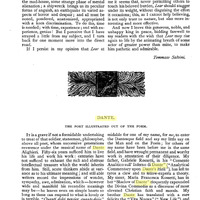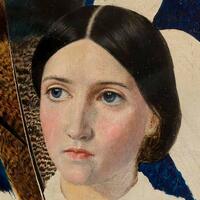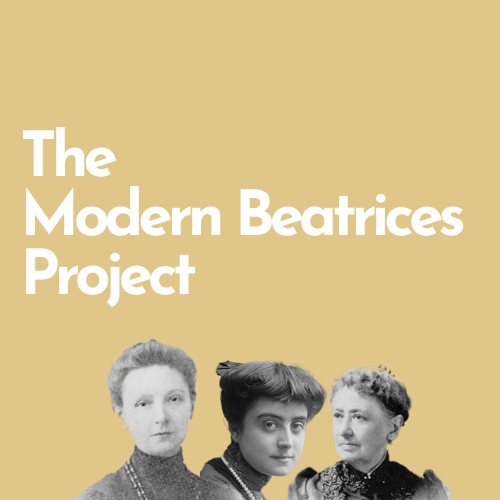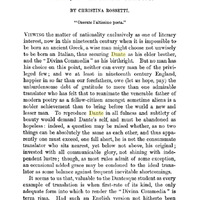Person
Rossetti, Christina Georgina (1830 - 1894)
- Title
- Miss Christina Georgina Rossetti
- Full Name
- Rossetti, Christina Georgina (1830 - 1894)
- Pseudonym
- Ellen Alleyne
- Lifespan
- 5 December 1830 – 29 December 1894
- Place of origin
- London
- Country of origin
- England, United Kingdom
- Language
- English
- Occupation
- Poet
- Short biography
-
Christina Rossetti was born in London to Gabriele Rossetti, a poet and a political exile from Vasto, Abruzzo, Italy, since 1824 and Frances Polidori, the sister of Lord Byron's friend and physician John William Polidori. She had two brothers and a sister: Dante Gabriel became an influential artist and poet, and William Michael and Maria both became writers. Christina, the youngest and a lively child, dictated her first story to her mother before she had learnt to write.
Rossetti was educated at home by her mother and father through religious works, classics, fairy tales and novels. Rossetti delighted in the works of Keats, Scott, Ann Radcliffe and Matthew Lewis. The influence of the work of Dante Alighieri, Petrarch and other Italian writers filled the home and influenced Rossetti's later writing. Their household was open to visiting Italian scholars, artists and revolutionaries.
In the 1840s, Rossetti's family faced financial troubles due to a deterioration in her father's physical and mental health. In 1843, he was diagnosed with persistent bronchitis, possibly tuberculosis, and faced losing his sight. He gave up his teaching post at King's College and though he lived another eleven years, suffered from depression and was never physically well again. Rossetti's mother began teaching to support the family, and Maria became a live-in governess, a prospect that Christina Rossetti dreaded. At the time her brother William was working for the Excise Office and Gabriel was at art school, leaving Christina increasingly isolated at home. When she was fourteen, she suffered a nervous breakdown and left school. Bouts of depression and related illness followed. During this period she, her mother and her sister became absorbed in the Anglo-Catholic movement that developed in the Church of England. Religious devotion came to play a major role in her life.
In her late teens, Rossetti became engaged to the painter James Collinson, the first of three suitors. Like her brothers Dante and William, he was a founding member of the avant-garde Pre-Raphaelite Brotherhood, established in 1848.The engagement ended in 1850 when he reverted to Catholicism. In 1853, when the family had financial difficulties, Christina helped her mother keep a school in Fromefield, Frome, but it did not succeed. A plaque marks the house. In 1854 the pair returned to London, where Christina's father died. She later became involved with the linguist Charles Cayley, but declined to marry him, also for religious reasons. A third offer came from the painter John Brett, whom she likewise refused. Rossetti sat for several of Dante Gabriel Rossetti's paintings. In 1848, she sat for the Virgin Mary in his first completed oil painting, The Girlhood of Mary Virgin, and the first work he inscribed with the initials "PRB", later revealed as standing for the Pre-Raphaelite Brotherhood. The following year she modelled for his depiction of the Annunciation, Ecce Ancilla Domini. A line from her poem "Who shall deliver me?" inspired a painting by Fernand Khnopff called I lock my door upon myself. In 1849 she again became seriously ill with depression, and around 1857 had a major religious crisis.
From 1842 onward Rossetti began writing down and dating her poems. Most of them imitated her favoured poets. In 1847 she began experimenting with verse forms such as sonnets, hymns and ballads, while drawing narratives from the Bible, folk tales and the lives of saints. Her early pieces often meditate on death and loss in the Romantic tradition. Her first two poems published were "Death's Chill Between" and "Heart's Chill Between", in the Athenaeum magazine in 1848. She used the pseudonym "Ellen Alleyne" in the literary periodical, The Germ, published by the Pre-Raphaelites from January to April 1850 and edited by her brother William. This marked the beginning of her public career.
Rossetti's more critical reflections on the artistic movement her brother had begun were expressed in an 1856 poem "In the Artist's Studio". Here she reflects on seeing multiple paintings of the same model. For Rossetti, the artist's idealised vision of the model's character begins to overwhelm his work, until "every canvas means/ the one same meaning." Dinah Roe, in her introduction to the Penguin Classics collection of Pre-Raphaelite poetry, argues that this critique of her brother and similar male artists is less about "the objectification of women" than about "the male artist's self-worship".
Rossetti's first commercially printed collection, Goblin Market and Other Poems, was published under her own name by Macmillan & Co. in 1862, when she was thirty-one. Dante Gabriel Rossetti became his sister's collaborator and created much-praised woodcut illustrations to the book which enhanced the effect of the work and emphasised its sensuality. Goblin Market was widely praised by critics, who placed her as the foremost female poet of the day; sales, however, were disappointing. She was lauded by Gerard Manley Hopkins, Algernon Swinburne and Tennyson. After its publication, Rossetti was named the natural successor to Elizabeth Barrett Browning, who had died the year before in 1861. The title poem, one of her best known, is ostensibly about two sisters' misadventures with goblins, but critics have seen it in various ways including an allegory of temptation and salvation, a comment on Victorian gender roles and female agency, and a work of erotic desire and social redemption.
Rossetti worked voluntarily in 1859–1870 at the St Mary Magdalene house of charity in Highgate, a refuge for ex-prostitutes. It is suggested that Goblin Market may have been inspired by "fallen women" she came to know. There are parallels with Samuel Taylor Coleridge's The Rime of the Ancient Mariner in religious themes of temptation, sin and redemption by vicarious suffering. Swinburne in 1883 dedicated A Century of Roundels to Rossetti, as she adopted his roundel form in a number of poems, for instance in Wife to Husband. She was ambivalent about women's suffrage, but many have found feminist themes in her work. She opposed slavery in the United States, cruelty to animals in prevalent vivisection, and exploitation of girls in under-age prostitution.
Rossetti kept a wide circle of friends and correspondents. She continued to write and publish for the rest of her life, mainly devotional work and children's poetry. In the years just before her death, she wrote The Face of the Deep, (1892) a book of devotional prose, and oversaw an enlarged edition of Sing-Song, originally published in 1872, in 1893. She died late the next year. - Selected List of Publications
-
 "Dante: the poet illustrated out of the poem"
"Dante: the poet illustrated out of the poem"
- Link to external sources
- Christina Georgina Rossetti - Wikipedia
Linked resources
- Resource class
- Person
- Media
-
 PORTRAIT
PORTRAIT
Part of Rossetti, Christina Georgina (1830 - 1894)
Annotations
There are no annotations for this resource.
Position: 3 (455 views)


